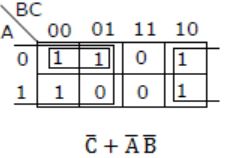Digital-Logic-Design
Question 1 |
bias of 127.
S : 1 E : 10000001 F : 11110000000000000000000
Here S, E and F denote the sign, exponent and fraction components of the floating point representation.
The decimal value corresponding to the above representation (rounded to 2 decimal places) is _______
A | -7.75 |
Sign bit S= 1. The given number is a negative number.
Biased Exponent E = 27 + 1= 129
Actual Exponent e = E-127
= 129- 127
= 2
The decimal value= (-1)s x 1.M x 2e
= (-1) 1 x 1.1111 x 22
= - (111.11)
= - (7 + 0.75)
= -7.7
Question 2 |
A | 21 |
B | 528
|
C | D2 |
D | 15 |
On converting (210)3 in decimal, we will get:=>
2*32+1*3=2*9+3=2110
=>(15)16
Question 3 |

A |  |
B |  |
C |  |
D |  |
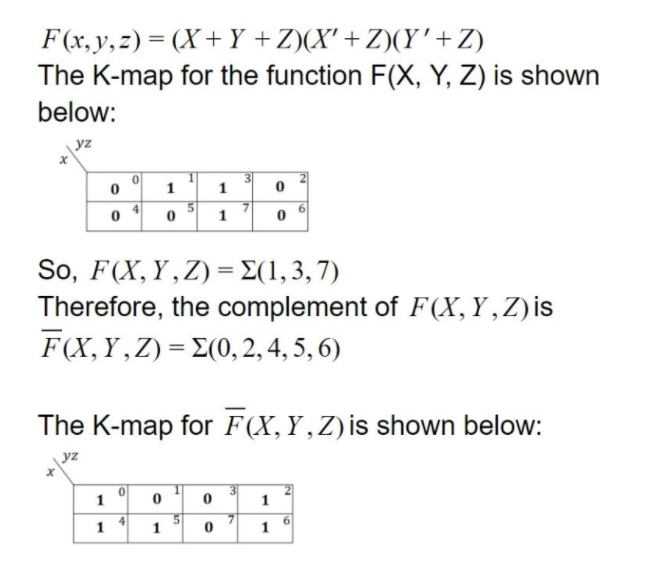
XY’+Z’ is a minimal SoP expression which represents the function (X,Y,Z).
The expression XY’ + YZ’ + X’Y’Z’ can be reduced to XY’+Z’
XY’ + YZ’ + X’Y’Z
= Y’(X+X’Z’) + YZ
= Y’(X+Z’) + Y
= XY’ + Y’Z’ + YZ’
= XY’ + (Y’+Y)Z’
= XY’ + Z’.
The expression (X+Z’)(Y’+Z’) is a PoS expression which also represents the same function (X,Y,Z).
Question 4 |

Which one of the following choices gives the correct values of x and y?
A | x is 1 and y is 1 |
B | x is 0 and y is 1 |
C | x is 1 and y is 0 |
D | x is 0 and y is 0 |
C2 checks the bits d1, d3, d4, d6, d7.
C2=1, d1= 1, d3= 1, d4= 0, d6= 0, d7= 1.
The number of 1s is even. So, even parity is used in this problem.
C1 checks the bits d1, d2, d4, d5, d7.
C1=0, d1= 1, d2= 0, d4= 0, d5= x, d7= 1.
As the parity used is even parity, the value of d5 should be 0.
x=d5=0
C8 checks the bitsa d5, d6, d7, d8.
C8=y, d5= x=0, d6= 0, d7= 1, d8= 1.
As the parity used is even parity, the value of C8 should be 0.
C8=y=0.
x=y=0.
Question 5 |
 Assuming the initial state of the counter given by PQR as 000, what are the next three states?
Assuming the initial state of the counter given by PQR as 000, what are the next three states?A | 011, 101, 000 |
B | 001, 010, 111 |
C | 001, 010, 000 |
D | 011, 101, 111 |
The truth table will be
|
RQP |
Rn Qn Pn |
|
000 |
011 |
|
011 |
101 |
|
101 |
000 |
Therefore, the next three states are : 101, 000 and 011

Question 6 |
Identify the logic function performed by the circuit shown in figure.

A | exclusive OR |
B | exclusive NOR |
C | NAND |
D | NOR |

So finally, we can write

Question 7 |
For the initial state of 000, the function performed by the arrangement of the J-K flip-flops in figure is:

A | Shift Register |
B | Mod-3 Counter |
C | Mod-6 Counter |
D | Mod-2 Counter |
E | Both A and C |

Circuit behaves as shift register and mod-6 counter. Note that this is the Johnson counter which is the application of shift register. And Johnson counter is mod-2N counter.
Question 8 |
Convert the following numbers in the given bases into their equivalents in the desired bases.
(a) 110.101)2 = x)10
(b) 1118)10 = y)H
A | (a) 6.625, (b) (45E)H |
= 4 + 2 + 0 + 0.5 + 0 + 0.125
= 6.625
(b) 1118 mod 16 = E, quotient = 69
69 mod 16 = 5, quotient = 4
4 mod 16 = 4
Writing the mods result in reverse order gives (45E)H.
Question 9 |
A ROM is used to store the Truth table for a binary multiple unit that will multiply two 4-bit numbers. The size of the ROM (number of words × number of bits) that is required to accommodate the Truth table is M words × N bits. Write the values of M and N.
A | M = 256, N = 8 |
Output will be of 8 bits.
So memory will be of 28 × 8.
So, M = 256, N = 8.
Question 10 |
Assume that only half adders are available in your laboratory. Show that any binary Boolean function can be implemented using half adders only.
A | Theory Explanation. |
Question 11 |
A control algorithm is implemented by the NAND – gate circuitry given in figure below, which A and B are state variable implemented by D flip-flops, and P is control input. Develop the state transition table for this controller.

A | Theory Explanation. |
Question 12 |
The logic expression for the output of the circuit shown in figure below is:

A |  |
B |  |
C |  |
D |  |
E | None of the above. |
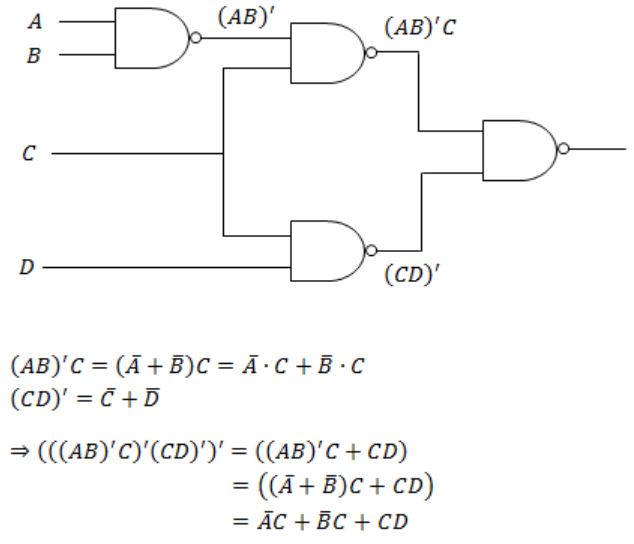
Question 13 |
The number of flip-flops required to construct a binary modulo N counter is __________.
A | ⌈log2 N⌉ |
Question 14 |
Consider n-bit (including sign bit) 2’s complement representation of integer number. The range of integer values, N, that can be represented is _________ ≤ N ≤ _________
A | -2n-1 to 2n-1 - 1 |
Question 15 |
Following 7 bit single error correcting Hamming coded message is received. (figure below):

Determine if the message is correct (assuming that at most 1 bit could be corrupted). If the message contains an error find the bit which is erroneous and gives the correct message.
A | Theory Explanation. |
Question 16 |
Write a program in 8085 Assembly language to Add two 16-bit unsigned BCD(8-4-2-1 Binary Coded Decimal) number. Assume the two input operands are in BC and DE Register pairs. The result should be placed in the register pair BC. (Higher order register in the register pair contains higher order digits of operand)
A | Theory Explanation. |
Question 17 |
Find the contents of the flip-flop Q2, Q1 and Q0 in the circuit of figure, after giving four clock pulses to the clock terminal. Assume Q2Q1Q0 = 000 initially.

A | Theory Explanation. |
Question 18 |
(a) Assume that a CPU has only two registers R1 and R2 and that only the following instruction is available XOR Ri, Rj; {Rj ← Ri ⊕ Rj, for i,j = 1,2}
Using this XOR instruction, find an instruction sequence in order to exchange
the contents of the registers R1 and R2.
(b) The line p of the circuit shown in figure has stuck at 1 fault. Determine an input test to detect the fault.
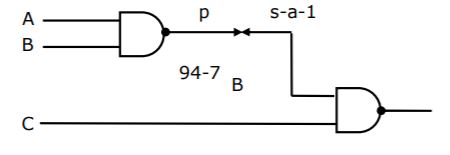
A | Theory Explanation. |
Question 19 |
What values of A, B, C and D satisfy the following simultaneous Boolean equations?

A | A = 1, B = 0, C = 0, D = 1 |
B | A = 1, B = 1, C = 0, D = 0 |
C | A = 1, B = 0, C = 1, D = 1 |
D | A = 1, B = 0, C = 0, D = 0 |
Question 20 |
The number of 1’s in the binary representation of
(3*4096 + 15*256 + 5*16 + 3) are:
A | 8 |
B | 8 |
C | 10 |
D | 12 |
= (11000000000000)2
15 × 256 = 15 × 28
= (111100000000)2
5 × 16 = 5 × 24
= (1010000)2
3 = (11)2
Hence, all binary numbers,

∴ 101's
Question 21 |
(a) Implement a circuit having the following output expression using an inverter and NAND gate ![]() .
.
(b) What is the equivalent minimal Boolean expression (in sum of products form)
for the Karnaugh map given below?
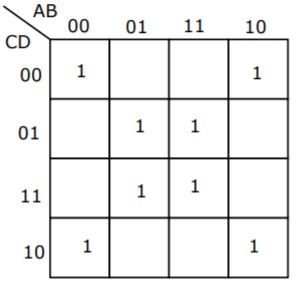
A | Theory Explanation. |
Question 22 |
(a) An asynchronous serial communication controller that uses a start stop scheme for controlling the serial I/O of a system is programmed for a string of length seven bits, one parity bit (odd parity) and one step bit. The
transmission rate is 1200 bits/second.
(i) What is the complete bit stream that is transmitted for the string ‘0110101’?
(ii) How many such strings can be transmitted per second?
(b) Consider a CRT display that has a text mode display format of 80 × 25 characters with a 9 × 12 character cell. What is the size of the video buffer RAM for the display to be used in monochrome (1 bit per pixel) graphics mode?
A | Theory Explanation. |
Question 23 |
A multiplexer is placed between a group of 32 registers and an accumulator to regulate data movement such that at any given point in time the content of only one register will move to the accumulator. The minimum number of select lines needed for the multiplexer is _____.
A | 5 |
A 25x1 Multiplexer with 5 select lines selects one of the 32(= 25) registers at a time depending on the selection input.
The content from the selected register will be transferred through the output line to the Accumulator.
Question 24 |
If there are m input lines and n output lines for a decoder that is used to uniquely address a byte addressable 1 KB RAM, then the minimum value of m + n is ____.
A | 1034 |
Each output line of the decoder is connected to one of the 1K(= 1024) rows of RAM.
Each row stores 1 Byte.
m=10 and n=1024
Question 25 |
Consider the Boolean function z(a,b,c).

Which one of the following minterm lists represents the circuit given above?
A | Z = ∑(0,1,3,7) |
B | Z = ∑(2,4,5,6,7) |
C | Z = ∑(1,4,5,6,7) |
D | Z = ∑(2,3,5) |
Convert a+b’c into canonical form which is sum of minterms.
a + b’c = a(b + b’)(c + c’) + (a + a’)b’c
= abc + abc’ + ab’c + ab’c’ + ab’c + a’b’c
= Σ(7,6,5,4,1)
Question 26 |
Consider three registers R1, R2 and R3 that store numbers in IEEE-754 single precision floating point format. Assume that R1 and R2 contain the values (in hexadecimal notation) 0x42200000 and 0xC1200000, respectively.
If R3 = R1/R2, what is the value stored in R3?
A | 0x40800000 |
B | 0x83400000 |
C | 0xC8500000 |
D | 0xC0800000 |

R1 = 1.0100..0 X 2132-127
= 1.0100..0 X 25
= 101.0 X 23
= 5 X 8
= 40

R2 = (-1) x 1.0100..0 X 2130-127
= (-1) x 1.0100..0 X 23
= (-1) x 101.0 X 21
= (-1) x5 X 2
= -10
R3 = R1/R2
= -4
= (-1)x 1.0 x 22
Sign = 1
Mantissa = 000..0
Exponent = 2+127 = 129

R3 = 1100 0000 1000 000..0
= 0x C 0 8 0 0 0 0 0
Question 27 |
A ROM is sued to store the table for multiplication of two 8-bit unsigned integers. The size of ROM required is
A | 256 × 16 |
B | 64 K × 8 |
C | 4 K × 16 |
D | 64 K × 16 |
No. of results possible = 28 × 28 = 216 = 64K
Then total size of ROM = 64K × 16
Question 28 |
Both’s algorithm for integer multiplication gives worst performance when the multiplier pattern is
A | 101010 …..1010 |
B | 100000 …..0001 |
C | 111111 …..1111 |
D | 011111 …..1110 |
Question 29 |
Consider the following floating point number representation

The exponent is in 2's complement representation and mantissa is in the sign magnitude representation. The range of the magnitude of the normalized numbers in this representation is
A | 0 to 1 |
B | 0.5 to 1 |
C | 2-23 to 0.5 |
D | 0.5 to (1-2-23) |
Question 30 |
Consider the circuit given below which has a four bit binary number b3b2b1b0 as input and a five bit binary number d4d3d2d1d0 as output. The circuit implements:

A | Binary of Hex conversion
|
B | Binary to BCD conversion |
C | Binary to grey code conversion |
D | Binary to radix-12 conversion |
Whenever, b2 = b3 = 1, then only 0100, i.e., 4 is added to the given binary number. Lets write all possibilities for b.
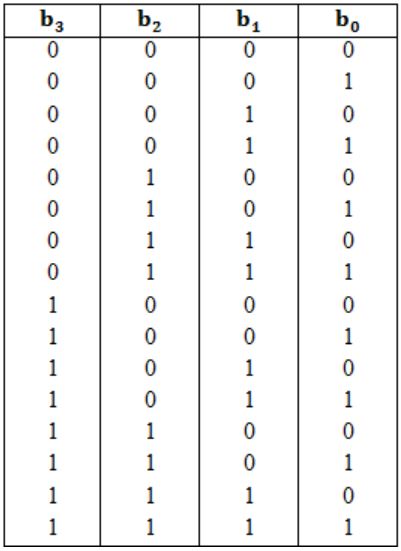
Note that the last 4 combinations leads to b3 and b2 as 1. So, in these combinations only 0010 will be added.
1100 is 12
1101 is 13
1110 is 14
1111 is 15
in binary unsigned number system.
1100 + 0100 = 10000
1101 + 0100 = 10001, and so on.
This is conversion to radix 12.
Question 31 |
Consider the circuit in below figure. f implements

A |  |
B | A + B + C |
C | A ⊕ B ⊕ C |
D | AB + BC + CA |
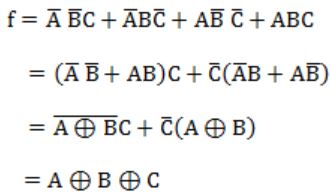
Question 32 |
What is the equivalent Boolean expression in product-of-sums form for the Karnaugh map given below.
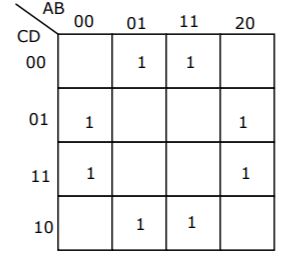
A |  |
B |  |
C |  |
D |  |
E | None of the above |


Question 33 |
A logic network has two data inputs A and B, and two control inputs C0 and C1. It implements the function F according to the following table.

Implement the circuit using one 4 to 1 Multiplexer, one 2-input Exclusive OR gate, one 2-input AND gate, one 2-input OR gate and one Inverter.
A | Theory Explanation. |
Question 34 |
Consider the synchronous sequential circuit in the below figure.

(a) Draw a state diagram, which is implemented by the circuit. Use the following names for the states corresponding to the values of flip-flops as given below.
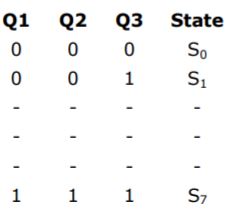
(b) Given that the initial state of the circuit is S4, identify the set of states, which are not reachable.
A | Theory Explanation. |
Question 35 |
In 16-bit 2's complement representation, the decimal number -28 is:
A | 1111 1111 1110 0100 |
B | 1111 1111 0001 1100 |
C | 0000 0000 1110 0100 |
D | 1000 0000 1110 0100 |
1’s complement = 1111 1111 1110 0011
2’s complement = 1’s complement + 1
2’s complement = 1111 1111 1110 0100 = (-28)
Question 36 |
Two numbers are chosen independently and uniformly at random from the set {1, 2, ..., 13}. The probability (rounded off to 3 decimal places) that their 4-bit (unsigned) binary representations have the same most significant bit is ______.
A | 0.502 |
B | 0.461 |
C | 0.402 |
D | 0.561 |
1 - 0001
2 - 0010
3 - 0011
4 - 0100
5 - 0101
6 - 0110
7 - 0111
8 - 1000
9 - 1001
10 - 1010
11 - 1011
12 - 1100
13 - 1101
The probability that their 4-bit binary representations have the same most significant bit is
= P(MSB is 0) + P(MSB is 1)
= (7×7)/(13×13) + (6×6)/(13×13)
= (49+36)/169
= 85/169
= 0.502
Question 37 |
Consider Z = X - Y, where X, Y and Z are all in sign-magnitude form. X and Y are each represented in n bits. To avoid overflow, the representation of Z would require a minimum of:
A | n bits |
B | n + 2 bits |
C | n - 1 bits |
D | n + 1 bits |
To store overflow/carry bit there should be extra space to accommodate it.
Hence, Z should be n+1 bits.
Question 38 |
Which one of the following is NOT a valid identity?
A | (x + y) ⊕ z = x ⊕ (y + z) |
B | (x ⊕ y) ⊕ z = x ⊕ (y ⊕ z) |
C | x ⊕ y = x + y, if xy = 0 |
D | x ⊕ y = (xy + x'y')' |
(x+y) ⊕ z = (1+1)⊕ 0 = 1 ⊕ 0 = 1
x ⊕ (y+z) = 1⊕(1+0) = 1 ⊕ 1 = 0
So,
(x+y) ⊕ z ≠ x ⊕ (y+z)
Question 39 |
What is the minimum number of 2-input NOR gates required to implement a 4-variable function function expressed in sum-of-minterms form as f = Σ(0, 2, 5, 7, 8, 10, 13, 15)? Assume that all the inputs and their complements are available.
A | 2 |
B | 4 |
C | 7 |
D | 1 |
E | 3(Option not given) |


Question 40 |
Consider three 4-variable functions f1, f2 and f3, which are expressed in sum-of-minterms as
f1 = Σ(0, 2, 5, 8, 14), f2 = Σ(2, 3, 6, 8, 14, 15), f3 = Σ(2, 7, 11, 14)
For the following circuit with one AND gate and one XOR gate, the output function f can be expressed as:
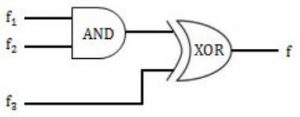
A | Σ (2, 14) |
B | Σ (7, 8, 11) |
C | Σ (2, 7, 8, 11, 14) |
D | Σ (0, 2, 3, 5, 6, 7, 8, 11, 14, 15) |
f3 = ∑(2,7,11,14)
f1*f2 ⊕ f3 = ∑(2,8,14) ⊕ ∑(2,7,11,14)
= ∑(8,7,11)
(Note: Choose the terms which are not common)
Question 41 |
Let * be defined as x * y = x' + y. Let z = x * y. Value of z * x is
A | x'+y |
B | x |
C | 0 |
D | 1 |
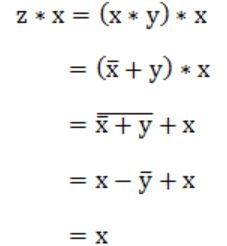
Question 42 |
An N-bit carry look ahead adder, where N is a multiple of 4, employs ICs 74181 (4 bit ALU) and 74182 (4 bit carry look ahead generator).
The minimum addition time using the best architecture for this adder is
A | proportional to N |
B | proportional to log N |
C | a constant |
D | None of the above |
Question 43 |
Let f(x, y, z) = x' + y'x + xz be a switching function. Which one of the following is valid?
A |  |
B | xz is a minterm of f |
C | xz is an implicant of f |
D | y is a prime implicant of f |
Question 44 |
Given √224)r = 13)r.
The value of the radix r is:
A | 10 |
B | 8 |
C | 5 |
D | 6 |
Convert r base to decimal.
√2r2 + 25 + 4 = r + 3
Take square both sides,
2r2 + 2r + 4 = r2 + 6r + 9
r2 - 4r - 5 = 0
r2 - 5r + r - 5 = 0
r(r - 5) + (r - 5) = 0
r = -1, 5
r cannot be -1,
So r = 5 is correct answer.
Question 45 |
Consider a logic circuit shown in figure below. The functions f1, f2 and f (in canonical sum of products form in decimal notation) are:
f1(w,x,y,z) = ∑8,9,10 f2(w,x,y,z) = ∑7,8,12,13,14,15 f(w,x,y,z) = ∑8,9

The function f3 is
A | Σ9,10 |
B | Σ9 |
C | Σ1,8,9 |
D | Σ8,10,15 |
Since, f1 and f2 are in canonical sum of products form, f1⋅f2 will only contain their common terms that is f1⋅f2 = Σ8.
Now,
Σ8 + f3 = Σ8,9
So, f3= Σ9
Question 46 |
What happens when a bit-string is XORed with itself n-times as shown:
[B⊕(B⊕(B⊕(B........ n times)]
A | complements when n is even |
B | complements when n is odd |
C | divides by 2n always |
D | remains unchanged when n is even |
Consider:
B⊕(B⊕B)
= B⊕0
= 0 (if consider n times it remains unchanged)
Question 47 |
A multiplexor with a 4 bit data select input is a
A | 4:1 multiplexor |
B | 2:1 multiplexor |
C | 16:1 multiplexor |
D | 8:1 multiplexor |
For 4 bit data it selects 24 : 1 = 16: 1 input
Question 48 |
The threshold level for logic 1 in the TTL family is
A | any voltage above 2.5 V |
B | any voltage between 0.8 V and 5.0 V |
C | any voltage below 5.0 V |
D | any voltage below Vcc but above 2.8 V |
Question 49 |
The octal representation of an integer is (342)8. If this were to be treated as an eight-bit integer is an 8085 based computer, its decimal equivalent is
A | 226 |
B | -98 |
C | 76 |
D | -30 |
If this can be treated as 8 bit integer, then the first becomes sign bit i.e., '1' then the number is negative.
8085 uses 2's complement then

⇒ -30
Question 50 |
The function represented by the Karnaugh map given below is:
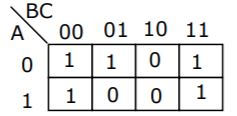
A | A⋅B |
B | AB+BC+CA |
C |  |
D | None of the above |
